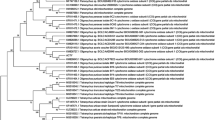Abstract
The phytophagous mite, Aceria litchii (Keifer), is one of the major pests of litchi (Litchi chinensis Sonn.) in Asia and Australia. By sucking on the cells of young leaves, the mites cause punctiform lesions. These are used by the parasitic alga Cephaleuros virescens Kunze to penetrate the leaf epidermis by forming a felt-like erineum. In the present study, significant positive relationships between mite density on algal infested leaves on the one hand and algal density and degree of erineum leaf cover on the other were found. In relation to these factors, the efficacy of different concentrations (0.036 g a.i. l−1, 0.072 g a.i. l−1 and 0.144 g a.i. l−1) and application frequencies (single and double) of spiromesifen, a lipid biosynthesis inhibiting agent, on the numbers of A. Litchii on litchi leaves was tested. Single spiromesifen applications significantly reduced numbers of mites per leaf by 34% at medium and by 77% at the highest concentration within 7 days after application. With double applications, numbers of mites were reduced by more than 80% at all concentrations 7 days after the second treatment. A complete elimination of A. Litchii was reached 18 days after the second application of the highest spiromesifen concentration. The degree of erineum cover and algal density did not significantly affect the efficacy of the double spiromesifen treatments, indicating that spiromesifen acts in a dose-dependent manner on A. Litchii.
Zusammenfassung
Einer der Hauptschädlinge von Litchi (Litchi chinensis Sonn.) in Asien und Australien ist die phytophage Milbe Aceria litchii (Keifer), die durch das Saugen an den Zellen junger Blätter punktförmige Läsionen auf der Blattoberfläche verursacht. Diese werden von der parasitischen Alge Cephaleuros virescens Kunze als Eintrittspforten zur Penetration der Blattepidermis genutzt, wodurch ein fellartiges Erineum entsteht. In der vorliegenden Untersuchung wurden signifikant positive Beziehungen zwischen der Milbendichte auf algeninfizierten Blättern einerseits und der Algendichte sowie dem Blattbedeckungsgrad des Erineums andererseits gefunden. Im Zusammenhang mit diesen Faktoren wurde die Wirksamkeit von Spiromesifen, einem Lipidbiosynthese hemmenden Wirkstoff, in verschiedenen Konzentrationen (0.036 g a.i. l−1, 0.072 g a.i. l−1 und 0.144 g a.i. l−1) und Applikationshäufigkeiten (ein-und zweifach) auf die Milbendichte auf Litchiblättern getestet. Innerhalb von 7 Tagen nach der einfachen Applikation wurde eine signifikante Reduktion in der Zahl der Milben pro Blatt von 34% bei der mittleren und 77% bei der höchsten Konzentration gefunden. Eine zweite Applikation reduzierte die Milbendichte bei allen Konzentrationen nach 7 Tagen um mehr als 80%. Eine vollständige Eliminierung von iA. Litchii wurde 18 Tage nach der zweiten Applikation bei der höchsten Spiromesifenkonzentration erreicht. Der Blattbedeckungsgrad des Erineums und die Algendichte hatten keinen signifikanten Einfluß auf die Wirksamkeit von wiederholten Spiromesifenapplikationen, was auf eine dosisabhängige Wirkungsweise hindeutet.
Similar content being viewed by others
Literature
Alam, M.Z., M.A. Wadud, 1963: On the biology of litchi mite. Aceria litchi Keifer (Eriophyidae, Acarina) in East Pakistan. Pakistan J. Sci. 15, 231–240.
Elbert, A., E. Brück, J. Melgareio, H.-J. Schnorbach, S. Sone, 2005: Field development of Oberon© for whitefly and mite control in vegetables, cotton, corn, strawberries, ornamentals and tea. Pflanzensch.-Nachr. Bayer 58, 441–468.
Lall, B.S., M.F. Rahman, 1975: Studies on the bionomics and control of the erinose mite Eriophyes litchi Keifer. Acarina: Eriophydae. Pesticides 9, 49–54.
Menzel, C.M., 2002: Major pests and diseases. In: C.M. Menzel (ed.): The Lychee Crop in Asia and the Pacific, pp. 74–83. FAO, RAP Publication 16, Bangkok, Thailand.
Nauen, R., T. Bretschneider, E. Brück, A. Elbert, U. Reckmann, U. Wachendorff, R. Tiemann, 2002: BSN 2060: a novel compound for whitefly and spider mite control. Proc. Brighton Crop Prot. Conf. Pests Dis. 1, 39–44.
Nauen, R., T. Bretschneider, A. Elbert, R. Fischer, R. Tiemann, 2003: Spirodiclofen and spiromesifen. Pestic. Outl. 14, 243–245.
Nicolaus, B., C. Romijn, L. Bowers, 2005: Ecotoxicological profile of the insecticide Oberon©. Pflanzensch.-Nachr. Bayer 58, 353–370.
Saha, K., A.K. Somchoudhury, P.K. Sarkar, 1996: Structure and ecology of Cephaleuros virescens Kunze and its relationship with Aceria litchi Keifer (Prostigmata: Acari) in forming litchi erineum. J. Mycopathol. Res. 34, 159–171.
Sharma, D.D., 1984: Control of litchi mite. Indian Horticult. Oct.–Dec., 27.
Sharma, D.D., M.F. Rahman, 1982: Control of litchi mite Aceria litchi (Keifer) with particular reference to evaluation of pre-bloom and post-bloom applications with different insecticides. Entomon 7, 55–56.
Sharma, D.D., S.P. Singh, R.K. Akhauri, 1986: Relationship between the population of Aceria litchi Keifer on litchi and weather factors. Indian J. Agric. Sci. 56, 59–63.
Somchoudhury, A.K., P. Singh, A.B. Mukherjee, 1989: Interrelationship between Aceria litchi (Acari: Eriophyidae) and Cephaleuros virescens, a parasitic alga in the formation of erineum-like structure on litchi leaf. In: G.P. Channaba-savanna, C.A. Viraktamath (eds.): Progress in Acarology, Vol. 2, pp. 147–152. Oxford and IBH Publishing, New Delhi.
Thakur, A.P., D.D. Sharma, 1990: Influence of weather factors and predators on the populations of Aceria litchi Keifer. Indian J. Plant Protect. 18, 109–112.
Waite, G.K., 1999: New evidence further incriminates honey-bees as vectors of lychee erinose mite Aceria litchi (Aceri: Eriophyiidae). Exp. Appl. Acarol. 23, 145–147.
Waite, G.K., 2005: Pests. In: C.M. Menzel, G.K. Waite (eds.): Litchi and Longan, Botany, Production and Uses, pp. 237–259. CAB International, Wallingford, UK.
Waite, G.K., J.D. Mcalpine, 1992: Honey bees as carriers of lychee erinose mite Eriophyes litchi (Acari: Eriophyiidae). Exp. Appl. Acarol. 15, 299–302.
Waite, G.K., U. Gerson, 1994: The predator guild associated with Aceria litchi (Acari: Eriophydae) in Australia and China. Entomophaga 39, 275–280.
Waite, G.K., J.S. Hwang, 2002: Pests of litchi and longan. In: J.E. Peña, J.L. Sharp, M. Wyzoki (eds.): Tropical Fruit Pests and Pollinators, Biology, Economic Importance, Natural Enemies and Control, pp. 331–359. CAB International, Wallingford, UK.
Author information
Authors and Affiliations
Corresponding author
Rights and permissions
About this article
Cite this article
Schulte, M.J., Martin, K. & Sauerborn, J. Efficacy of spiromesifen on Aceria litchii (Keifer) in relation to Cephaleuros virescens Kunze colonization on leaves of litchi (Litchi chinensis Sonn.). J Plant Dis Prot 114, 133–137 (2007). https://doi.org/10.1007/BF03356721
Received:
Accepted:
Published:
Issue Date:
DOI: https://doi.org/10.1007/BF03356721



